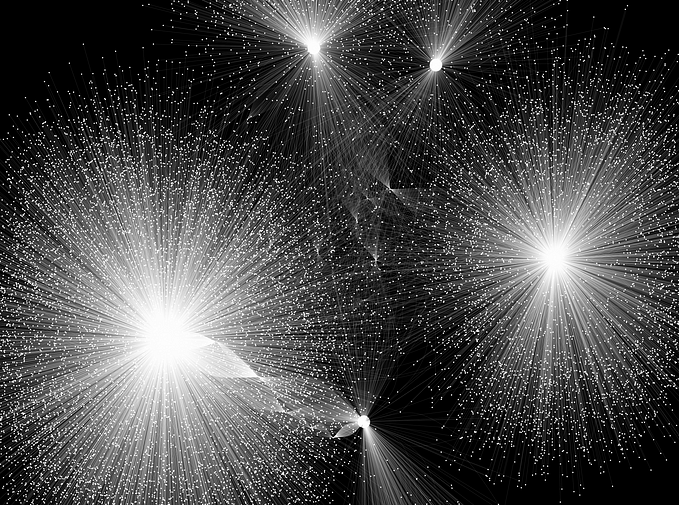Visualizing Ethereum’s History

This post explains Ethstory, an NFT project that describes Ethereum’s history through data visualization. Ethstory has a charitable goal. 100% of all initial sales are going to charity. Links to transactions into public addresses for charities can be found here. Series 4, the final series, will be released as an OpenSea auction this Friday, April 30th at 5pm NYC time. All proceeds to charity.
Backstory: alluring history in data
Ethereum is amazing. You don’t even have to like Ethereum to have this opinion. Just take in some cold, dispassionate facts. Ethereum now serves as a base layer for trillions of US dollars of yearly transacted value across diverse projects that are all built upon it: autonomous organizations, decentralized finance, digital ownership, identity and name services, and more. Yet, its mainnet is not 6 years old. And while we wait for it to evolve into Eth2, it is doing all of this on barely 20 transactions per second.
It is a historic technical achievement.
These successes are also a social achievement. The community surrounding Ethereum is just as important as its Turing-complete technical specification. What drew me deep into the rabbit hole in 2018 was the early NFT community. Meandering various Dapps with a freshly setup MetaMask felt like installing an early mod onto my reality. The notion of digital ownership, amidst all the other stuff built on Ethereum, seemed like an alluring, amorphous upgrade to everything I was doing on the Internet.
My favorite thing about Ethereum, and public blockchain in general, is its treasure trove of data. In 2019, I wrote a couple of blog posts for the wonderful OpenSea. One showed that we can predict ENS name value from applied natural language processing. Another blog post described an experimental NFT recommender system. I created a series of experimental data-driven interfaces, many of them for NFTs. I also contributed a diagram to OpenSea’s great NFT Bible, illustrating how wallets own across NFT projects.

In all of this fun, I could not stop thinking about history. Despite the aggressively futurist orientation of public blockchain, it also contains a robust signature of the past. A public blockchain encodes its complete history, accessible to all. Inside this history are data that can describe the micro and the macro, from individual wallets to mass-scale transaction dynamics across an entire digital ecosystem. The data summon you to look back. Right now, without any cost to you except a click, you can jump into the amazing Etherscan and peruse the transactions emanating from the very first wallets on Ethereum. You wonder who they are, what they were up to. Of course, lots of these wallets sent their spoils straight into Kraken 1. Many hodled. And others generated a meshwork of transactions revealing what was to come: DAO, ICO, DeFi, NFTs, and so on. From this vantage point, blockchain is just as exhilarating as a study of its own history.
Since those early posts, I took to sharing visualizations on Twitter. These visualizations often contained flavors of history. I was asked to make NFTs out of these sorts of visualizations. With the lure of history always hovering, I accepted the challenge. Ethstory was born of a Steinwoldian GENESIS.

Setup: Ethstory, goals and guidelines
Ethstory is a study of Ethereum’s history using data visualization. These visualizations are issued as 4 series of 4 NFTs (16 total originals in 110 editions), illustrating successive periods of Ethereum’s past. You could call these visualizations art, if you wish. But I am not an artist; by trade, I am a sort of data scientist. You could also describe Ethstory’s visualizations as “stealth infographs,” in that they look like an artistic production but they are rendered entirely from on-chain and other data. Because they are rendered entirely from data, each element of Ethstory’s visualizations is a vector object. So I also issued them as vector-quality PDFs that only owners can access via OpenSea’s unlock feature. (PDFs are encrypted and stored on IPFS, and OpenSea gives owners a password to decrypt them.)
I had a few guiding ideas for Ethstory. Here they are.
Charity. I’m of modest means, but I am indeed very lucky to be able to work from home during such difficult times. I decided to devote all auctioned pieces to charity, and to focus on charities that help those most in need. Thanks to public blockchain, you can peruse the outgoing ETH from the project’s wallet and see which charities have been supported. (So far, over 20 ETH have been donated to such initiatives as GiveDirectly, GiveWell, India Covid-Crypto Relief Fund, Heifer International, and more.)
Simple, integrated themes. I decided to focus on fundamentals — white vs. yellow papers, clients, transaction graphs, token projects, and so on. Ethstory should be understandable by someone new to Ethereum, but (I hope) intriguing enough for an old hand to take interest. The data should be laid out in such a way that these fundamentals should emerge from a description of each piece. Although each visualization is distinct, they are motivated by a set of themes used throughout the originals so that Ethstory is more like an integrated set rather than a bundle of independent pieces.
Carved with data. As much as possible, everything should be data driven. Only in rare cases did I depart from generating a visual directly from data, and use aesthetics untethered from it. The originals should be carved out of data. I almost veered from this principle once and solicited helpful feedback from Andrew Steinwold. He reminded me of the principle that the data should speak to the history as much as possible.
Research. “Who are you to do an Ethereum history?” “This is public blockchain; I can do this and you can’t stop me.” In seriousness though, it is important to stay true to the origins. I am not an OG. I was not at the “Red Wedding” described in Cami Russo’s amazing biography of Ethereum. So I made use of primary and secondary sources to guide Ethstory, including on-chain data from a full node synced according to current practices (cough AWS cough). Over the past few years, getting acquainted with Bitcoin, Ethereum and blockchain came from many books and blogs: Mastering Bitcoin, Mastering Ethereum, Digital Gold, The Infinite Machine, Out of the Ether, ethereum.org, ethhub.io, and more. It’s also amazing how incredibly friendly Ethereans are (and many in blockchain generally), and so knowledge comes from engaging this amazing kindness described here.
Finally, I hosted the project’s website on IPFS + ENS, ethstory.eth.link, and registered it to the year 2043. There, you can get lots more information about the originals and the underlying data, along with lots of information for owners.
Anyway, those are the guidelines. Here are some results.
Themes, illustrations
Here is an illustration of some themes from originals in Ethstory. As noted above, the idea is to have visual themes cut across pieces, so that major elements of Ethereum are conveyed by these themes.
Expansion. Branching processes, especially in network diagrams, give the feel of a system that is spreading, expanding and widening its nature and influence.

Ecosystem. Circular and spherical rendering methods give the data the feel of an integrated, growing ecosystem.

Composition. Parts and components fitting together, being assembled from various parts to create a new whole: composability.

Flows in, out. Two major changes in Ethereum’s lifespan, one from the past, and one forthcoming. Which connotes an eerie emptied entity, and which a new system poised for flourishing growth?

Ethstory’s visualizations begin by plotting documentation from 2013, when Vitalik Buterin shopped around an intriguing white paper. The visualizations end with 2021, with data from the Beacon chain, showing the growing Eth2 deposits and highlighting the first validators on Eth2. Across these eras, these themes are used in distinct ways. The visualizations can look quite different, but adopt some similar underlying attributes. On OpenSea, each accompanies a detailed narrative. Here are the final words from the last original in Ethstory, to be released this Friday at 5pm (NYC time):
This original uses thousands of transactions from Eth2 depositors into the Eth2 contract. Nodes are depositors and their size reflects how much ether had been deposited by each. Nodes are arrayed on a circular graph folded onto itself and jittered. Edges reflect the many deposits, and lines shown are numbered proportionally for each depositor’s on-chain data. The blue pool of expanding deposits has its radius locked onto a cumulative sum of ether put into the contract, ending at its outer ring with over 2% of all ether. With Original 3 and this Original 4, we see depicted the future of Ethereum — the promise of orders of magnitude scaling in transaction throughput, and a digital ledger that is sustained by its own PoS algorithm that runs on skin in the game. We await its future.

Beyond Ethstory
Ethstory is complete. It will only ever have 16 originals in 110 editions. There will be no more issuance of these visualizations, though you may see some of the themes emerge in new ways. This project could have been called Eth1story, because we’re still in the early stages. Eth2story seems reasonable in the future, but we await its impact and, of course, more data.
Those who supported Ethstory supported important charities. Thank you so much to owners. Thanks also to Andrew Steinwold and Sfermion for stewarding this project. Though they offered guidance to the project and are holding a complete series of Ethstory, they contributed ether for the charitable endeavor, too.
For updates on upcoming projects, follow me on Twitter, and together we can burrow deeper into the proverbial rabbit hole.
Thanks to Nic Carter and Andrew Steinwold for feedback. This post was also shared via Zima Red earlier this week.









